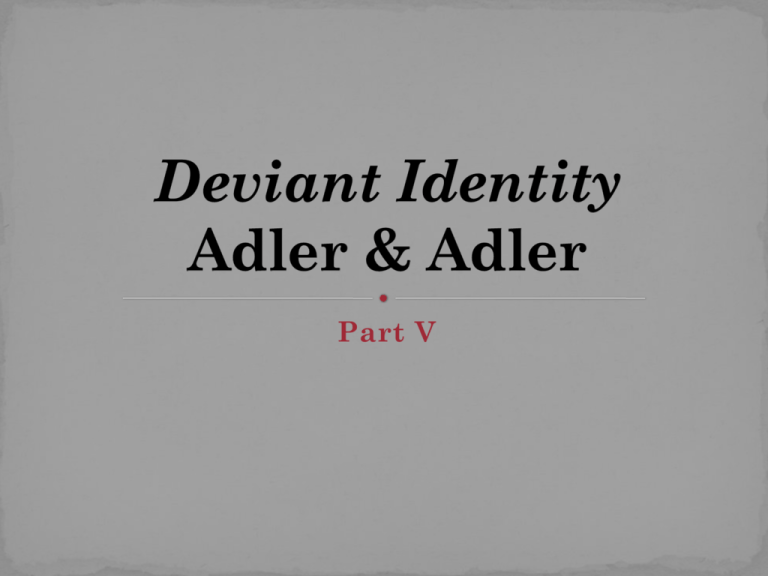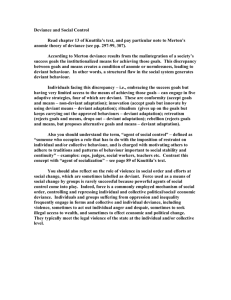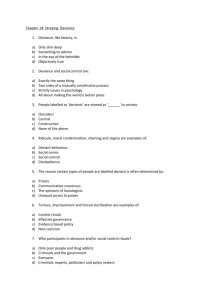Deviant Identity Adler and Adler
advertisement

Part V Part 5 Many people engage in deviance but only a small percentage labeled deviant Pathway of deviant identity may be a “deviant” (Becker) or a “moral” (Goffman) career Deviant identity career: seven stages (Adler & Adler) Part 5 Getting Caught & Publicly Identified Once labeled a person’s life changes in several ways Others begin to think differently about newly labeled person Part 5 Retrospective Interpretation (Schur) Reviewing new deviant’s past & current behavior to see if it warrants being seen in a different light Part 5 Spoiled Identity (Goffman) Erikson: commitment ceremonies publicly announce one as deviant A tarnished reputation is not easy to restore, few if any rites of passage exist Part 5 Exclusion (Lemert) Deriding and ostracizing: the new deviant is excluded from reputable social groups Part 5 Inclusion (Lemert) As membership from some groups is closed, other deviant groups may welcome or include the newly labeled deviant into their deviant circles or groups A deviant reputation will be repelling to some but attractive to other groups Part 5 Treated Differently Others indicate negative view of deviant through actions & expression of attitudes Part 5 Internalization of the Label (Cooley) Looking Glass Self: a person internalizes deviant label and begins to think of themselves differently Part 5 Part 5 Master status is one that defines our primary identity, such as: Race, Gender Age Religion Part 5 Auxiliary traits are qualities often associated with a master status, such as: Heroin-user Sexually promiscuous Obese Ex-felon Part 5 One who commits deviant acts but such acts are unrecognized As a result, one avoids being labeled deviant and avoids deviant identity Some persons may remain at this level indefinitely while committing deviance Part 5 One commits deviant act and such acts are reacted to by others as deviant Seven stages above describe this process of secondary deviance Role engulfment (Schur): one who defines oneself primarily through deviant identity and accepts this as primary status Part 5 Identity Embracement: person decides deviant label is unjust not intrinsic to their behavior They strongly identify with their deviance and often organize with others to combat the deviant label applied to them May engage in “identity politics” such as protests, rallies, civil disobedience, etc Gender (view of women as inferior and movement to win women’s right to vote) Race (view of blacks as inferior and civil rights movement), Sexual orientation (gay/lesbian movement) offer historical examples Part 5 Part 5 In conversation we present reasons to others to explain meaning and intent of our actions Such “motive talk” provides normalcy to interactions that are disrupted by certain acts or events Part 5 People make “justifications” for deviance seen as valid by deviants but not by legal system or society Denial of responsibility: deviance due to acts or situations beyond their control Denial of injury: mitigate act by alluding to lack of harmful consequences to anyone Part 5 Denial of the victim: legitimate their behavior by suggesting no specific victim can be identified that persons hurt “deserve” what happened to them Appeal to higher loyalties: behavior justified as serving a greater good Condemnation of the condemners: turning the table on accusers focus on what accusers have done wrong Part 5 Deny full responsibility by distancing themselves from blame Four types of excuses Appeals to accidents Appeals to defeasibility Appeals to innate, biological drives Scapegoating Part 5 Deny wrongfulness of act Accept full responsibility Two types of justifications Sad tales Self-fulfillment Part 5 Disclaimers in contrast are prospective in nature Designed as verbal explanations to minimize deviant acts or motives that will occur in future Argue that Scott and Lyman’s verbal accounts are retrospective in nature to minimize impact of deviant behavior that has already occurred Part 5 Hedging: Prefacing behavior with remarks suggesting lack of certainty as to what they are can do or will achieve (I am not sure this is going to work but...”) Credentializing: Knowing their act will be discredited, they attempt to give a purpose or legitimacy to it Sin licenses: Knowing their behavior will not be well received, they suggest this is a time when the ordinary rules should be suspended Part 5 Cognitive disclaimers: Try to make sense of something that looks as if it would not be well understood Appeals for the suspension of judgment: Aim to deflect negative consequences of offensive remarks Part 5 Part 5 Deviant label marks people with a stigma in eyes of society, leading to devaluation and exclusion Stigmatized persons fall into two categories (Goffman) Discreditable: easily concealable deviant traits who may manage themselves to avoid the stigma (ex-convicts, secret homosexuals, former or current prostitutes) Discredited: Those who have revealed their deviance or who cannot hide it (the obese, racial minorities, physically disabled) Part 5 Those with discredited stigma engage in passing as “normal” in everyday life: constant focus on secrecy and information control to conceal deviance through: Stigma symbols -avoid contact with objects or behaviors that would tip others off about to their deviance Part 5 Disidentifiers: props, actions or verbal expressions to distract or fool others Leading double life: maintaining two different lifestyles Others may help others conceal their deviance by covering for them Disclosure: stigma management if concealment fails Part 5 Disclosure follows one of two courses: Deviance disavowal: some normal people ignore a person’s stigma Deviance avowal: deviant person may acknowledge their deviance but present themselves in a positive light Part 5 Stigma may also be managed through group or collective effort Example: AA, COYOTE Expressive dimensions: primary function to provide support for members Instrumental dimension: members gather in addition for political activism: NOW Groups vary between conformity and alienation Part 5 Part V Chapter 23 Data collection for this study consists of field observations and in-depth interviews Identity Change Process Part 5: Ch. 23 Identity change involves two levels: Public (external): social status is socially defined and promoted and involves public cues Private (internal): as a person recognizes current status is inappropriate they locate new status Identity change is thus mediated through status cues that exist in environment Part 5: Ch. 23 Status cues are the public or external part of the identity change process Recognizing and placing comprise internal component of identity change process Identity change process involves external and internal elements Status cues transmitted in two ways: Active cues communicated through interaction: others tell person they are “fat” Passive cues require individual to inform themselves about their relevance Part 5: Ch. 23 What makes the identity change process possible? Which cues are more important in changing an individual’s view of themselves – status or passive status cues? Part 5: Ch. 23 Part V Chapter 24 Part 5: Ch. 24 Becoming bisexual involves rejecting two recognized categories of sexual identity: heterosexual and homosexual Initial confusion: first stage of bisexual identity formation Persons report experiencing period of considerable confusion, doubt and struggle about their sexual identity prior to defining themselves as bisexual Part 5: Ch. 24 They report having strong sexual feelings or both sexes that was unsettling, disorienting and sometimes frightening which they did not know how to handle Others were confused because they thought same sex feelings or behavior meant end to their longstanding heterosexuality A third source of confusion was due to unsuccessful attempt to categorize such feelings or behaviors A final confusion due to homophobia: difficulty for some in facing up to same-sex component of their sexuality Part 5: Ch. 24 Finding and applying the label: second stage of bisexual identity formation Discovery of category and label of bisexuality a turning point for many For others, their first gay or straight experience coupled with recognition that sex could be pleasurable with both sexes Part 5: Ch. 24 For others no specific experience but simply recognition that sexual feelings for both sexes just too strong to deny & unnecessary to choose one over the other Encouragement and support of others who already defined themselves as bisexual including sex-positive organizations Part 5: Ch. 24 Settling into the identity: third stage of bisexual identity formation This stage often result of becoming more self- accepting, less concerned about negative attitudes of others about sexual preferences Self-acceptance often attributed to support from friends, counselors, organizations and reading While a majority of subjects seemed “settled into” their bisexual identity, 40% report that they could someday define themselves as lesbian/gay or heterosexual Part 5: Ch. 24 Continued uncertainty: fourth stage of bisexual identity formation Belief that bisexuals are confused about their “true” identity is quite common and has often been promoted by some homosexuals Subjects report periods of doubt and uncertainty even after discovery and application of bisexual label to themselves Part 5: Ch. 24 What does the formation of a bisexual identity entail and how easy or difficult is this for the individual? Part 5: Ch. 24





